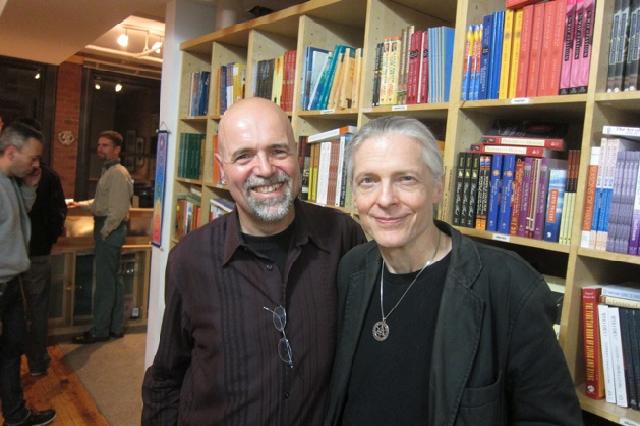January 2012 / Notes from the Field Integral Leadership Review
Barbara Larisch and Robin Reinach

Does Integral make us happier? Martin Ucik questioned at the beginning of his presentation to Integral New York on Oct. 17, 2011. This issue hung in the air throughout Ucik’s presentation at iNY’s beautiful new home at One Spirit Interfaith on West 36th Street. Our long rectangular room was packed with double the usual number of participants, sitting in rows of chairs lined tightly together, instead of our usual loose circle. This swell in participation is attributable to the topic of Ucik’s book: Integral Relationships: A Manual for Men. A remarkable number of people—both men and women—turn out for presentations that promise to shed light on romantic relationships. At the outset of his talk, Ucik admitted that his book was written for men, as the subtitle clearly proclaims. Further, Ucik explained that his book began as a personal inquiry into his own misadventures and challenges in maintaining a sustainable romantic relationship.
After Ucik’s marriage of fourteen years dissolved, Ucik felt befuddled and confused. Entering the singles scene, he was immediately struck by how much the landscape had changed since the last time he had sought a partner. These changes occurred had over time and across cultures. The iNY audience was introduced– through a series of slides – to Ucik’s family of origin in Germany. Born in 1957 into a middle class family that he characterized as living together in harmony through the use of strict BLUE/ amber structure, Ucik found the changing gender roles in the US quite different from his childhood experience where Father ruled the roost, Mother knew her place, and the rest of the family fell into the roles expected of them. Ucik’s sense of humor was engaging as he shared with iNY his shock upon arriving in the US and beginning to date. The audience laughed with Ucik, easily empathizing with his confusion and dismay at the current state of romantic relationships in 21st Century America.
As women and Integralists, we both admired Ucik’s honesty and his willingness to be vulnerable. We further appreciated the fact that he shared his first-person perspective with such humility and good humor. This first person openness was quite unexpected, given that many people have remarked that Ucik’s manual on Integral Relationships is incredibly dense and presented entirely from a third-person perspective. Perhaps Ucik is aware of this feedback about the limitations of 3rd person perspective, and he is already incorporating additional perspectives in response. That would be wonderful—an example of an Integral feedback loop working the way we hope it will: as true discourse where aspects of each perspective offered can widen and deepen the theory. Ucik may well be learning from participants in his presentations; evidence points toward this idea as Ucik directly expressed awareness that his speeches had been triggering to participants in the past. This reactivity, which Ucik has come to expect in a good natured way, also arose in the field of the Integral New York audience. Fortunately, reactions ranged from humorous and well-intentioned skepticism to a heartfelt desire to challenge some common assumptions about gender that Ucik (to these authors) seemed all too ready to embrace.

Martin after his talk at Integral New York with Alex Grey
During his 60 minute PowerPoint presentation, gender stereotyping made Ucik’s speech funny and accessible, but came dangerously close to caricature. Bursts of laughter and spurts of emotional energy from the audience accompanied Ucik’s presentation, engaging the audience at the cost of a more nuanced and deep exploration of gender issues. In this spirit of fun, Ucik kicked off his presentation by treating the room to a series of fun facts about relationships:
- 86 Million Americans (44% of the adult population) are considered to be single.
- Over 30 Million adults are trying to find a partner on-line.
- Approx. 50% of marriages in America will end in divorce.
- Only about 3-15% of Americans are having a really good time in their relationships.
- Two thirds of divorces are filed by women.
- Men suffer more emotionally after a breakup.
- The resulting suicide rate of divorce fathers is ten times higher than that of divorced mothers.
- Women read 95% of all relationship books.
A series of guffaws accompanied these “facts.” (How can we possibly know that women read 95% of relationship books? And yet, there is a kind of truth revealed by this statistic, isn’t there?) Knowing chuckles bubbled up in acknowledgement of clichéd statistics clearly pointing to troubled relationships, with stereotypical women reading up on how to fix them.
Next, with his usual candid charm, Ucik warned that his book was based on heterosexual relationships and had arisen from his particular masculine point of view. Here again, the authors appreciated Ucik’s candid acknowledgment of his own filters and the unavoidable effect of his personal perspective on the body of his work. The style of Ucik’s presentation seems to have transcended the style and content of his book. Again, this appears to be evidence that Ucki’s personal evolution is being impacted by his interactions with responses to his work.
Continuing to look under the surface of relationship for motivations, Ucik gave a passing nod to Jung’s concept of anima, animus. Next he began to do a workmanlike job of deconstructing motivation and relationship patterns, using AQAL terminology. We were encouraged to ask what lines of intelligence were necessary and or helpful for “good” relationships: interpersonal, psychosexual, spiritual? We looked at relationship through the lenses of quadrants, and then we asked how levels of consciousness relate to choice of mate. There was a brief explanation of the metaphor ladder, climber, view as applied to relationships, along with a whirlwind tour of SDi.
Primary Fantasies and Male/Female Differences
Ucik’s summary of his theory began with the assertion that men wanted “sex” objects and women wanted “success” objects. (One author was attending the presentation with a PhD biologist friend who immediately whispered, “Men want reproductive objects.”) Ucik defined the kind of success women look for in men as: social status, power, height, and wealth/earning potential. Focusing on the economic aspect of success, Ucik asserted that a problem had arisen (according to his statistics) because there simply are not enough men with a monetary “success” level to satisfy the number of women looking for “successful” men.
Using research from Warren Farrell’s book, Ucik presented us with a compelling graph. The distribution of income in the US was illustrated using a bell curve and it showed that most men (on average) earn $35,000/year while the majority of women are typically attracted to men who earn $150,000/year or more. This creates an obvious imbalance (think supply and demand) and leads to stiff competition among women for the wealthier, more powerful men. It also means that many “average” income men are not considered desirable by women. A quick survey of this situation shows how both men and women can easily find themselves alone simply because they don’t live up to each other’s unrealistic criteria for success or attractiveness. There are leagues of women who can’t find men who make over $150,000 to mate with, and leagues of men who have insufficient resources (less than $150,000 annual salary) to attract women. This situation is clearly a cultural recipe for loneliness and disappointment. Ucik points to this dynamic as a huge cultural shadow. As women, the authors are well aware of these modern remnants of our biological conditioning and the painful power discrepancies that arise because of them. Like Ucik, we find these conditions difficult to bear.
In a recent newsletter, Ucik described his personal experience:
“I admit that I was quite upset and frustrated in the past when I was rejected by attractive women because of my average income, low social status, and for having children (and if I hear the same from other men). Now that I understand the difference in our cultural background and the real or perceived necessity for women to be with men in the top income brackets, I no longer get upset. Instead, I feel compassion, as I know from being a dating coach how hard and frustrating it is for most single women to find/attract and keep a high earning man (if you need more evidence read Marry Him: The Case for Settling for Mr. Good Enough by Lori Gottlieb or one of the many other books for modern women seeking successful men).”
Perhaps it might be meaningful to explore whether these ‘primary fantasies’ and gender stereotypes still hold true within the Integral community. For example, do our expectations still contain shadow elements to some extent, or have we succeeded in transcending and including our basic biological drives and dispositions? If so, what would that look like? Can we Integralists –through the use of awareness and higher level wisdom—acknowledge that these primary fantasies exist and embrace the healthy expression of our biological drives while still honoring the Other? Aren’t most acts of consciousness expansion dependent upon our ability to choose not to behave on auto pilot, in accordance with instructions encoded into our genes to ensure the survival of our ancestors?
According to Ucik, fantasies about the ideal mate have the potential to evolve along with the rest of our thinking. There is a chance, he asserts, that what men consider to be “sexy” and/or attractive will change in the decades to come. Ucik also hopes that women’s perceptions about what they need from men as partners can evolve away from money and status to allow lower income, lower status men to participate in relationships. Paradoxically, women who are financially independent currently represent a unique challenge to men, and Ucik does his best to coach men on how to navigate this terrain in the section of his book dedicated to Levels of Growth.
Levels of growth seem extremely important for harmony in relationship. Shared interests and values promote more flow and less conflict, if smooth sailing is the goal in relationship. However, even if the standards for sex objects and success objects are lowered to a more realistic level, we will only see less attractive women meet and feel OK about less wealthy, lower status men. These relationships will still be occurring between sex objects and success objects, however much more pragmatically calibrated. What seems painfully missing is the I/Thou relationship as described by Martin Buber. Where is the second person perspective? How can we talk about relationship without using the lens of 2nd person perspective? Ucik’s book gives us a thorough 3rd person analysis of relationships through AQAL lenses, and his talk added the authenticity of 1st person perspective. But the 2nd person perspective has yet to be been addressed.
Remember the question Ucik posed at the outset of his presentation: Does Integral make us happier? It seems that people in I/It relationships (trading goods for services, attractiveness for economic power etc) are less likely to be happy than people in I/Thou relationships. And by the way, whatever happened to love? Not the tired cliché, but the powerful appreciation and connection that do not rely on an exchange of worldly goods. Is this where transcend and include comes to life? What does love look like at each level of the spiral?
Sex-Based Emotional Reactions: The Female Fear-Male Shame Dynamic
Continuing to bring up main points from his book, Ucik cited fear as a primary driving force for women, and shame as a primary driving force for men in relationships. In his book, Ucik describes how a woman’s fear of abandonment gets triggered when communication breaks down and she no longer experiences an emotional connection with her mate. Acting from mainly an unconscious level, the woman starts to withhold sex, nag, criticize and challenge her partner (or passive-aggressively ignore him) without having a clue how she is undermining the partnership by doing so. According to Ucik, Patricia Love & Steven Stosny (authors of How to Improve Your Marriage Without Talking About It) see these negative tactics that arise from a state of despair as “critical and demeaning” to men and we can only assume that they contribute to the male’s downward spiral of shame. How a man reacts to these desperate and frustrated attempts by women to receive reassurance and support are critical to the health and the well being of the relationship. Unfortunately, most men will respond by either withdrawing or getting angry – and both reactions are unconscious attempts to protect oneself from the female partner’s ongoing emasculations.
On the other hand, it may be helpful to remember that both genders experience shame and fear. Depending on type, level and life circumstances these emotions arise and fall along with many others. It seems hard to justify assigning either gender a preference for shame or fear in relationship style—there are just too many variables. Take the Enneagram system, for example. As most of you know, the nine personality types are divided into three core groups: the Instinctive Center (with the core emotion being Anger or Rage, the Feeling Center (with the core emotion being Shame) and the Thinking Center which has Anxiety or Dread at its core.
An examination of the fear/shame dynamic is undoubtedly useful, but it may be helpful to point out that not all couples therapists agree that fear of abandonment is the driving force of unhappiness and despair in relationships. Fortunately, Ucik agrees with this premise, although he didn’t provide much context for this alternative view in his presentation. To his credit, Ucik lists David Schnarch’s book, Passionate Marriage: Keeping Love and Intimacy Alive in Committed Relationships as a resource for post-conventional couples in the back of his book. However, some might argue that Schnarch offers an integral approach to couples therapy and we believe that this might be an area well worth exploring further. Coincidentally, Schnarch has the lead article in this month’s Psychotherapy Networker. In regard to the fear and shame of clients in couple therapy, he has this to say:
“Thirty years of working with couples and observing the limitations of this attitude [bad behavior in troubled relationships stems primarily from good intentions gone wrong] has led me to develop an approach not focused on clients’ fears, insecurities, or wounded “inner child,” or on the deficiencies of their early attachments. Instead, it reflects the idea that people typically don’t hurt each other because they’re out of touch, unable to communicate, or can’t help themselves because of their early experiences: they usually know the harm they’re doing, and often it is quite deliberate. Rather than triggered by fear, shame, or insecurity, people do hurtful things with impunity and entitlement to gratify their own needs and wishes. It’s not that they’re “unconsciously recreating their past,” it’s that they’re engaging in the form of relationship with which they’re most familiar, one that, in fact, they prefer.”
Identifying Stages of Sex
From the bottom of the spiral upward, Ucik summarized sexuality as it manifested at each stage: repressed, fucking whatever I can get away with, sex as an agreement, lovemaking as an expression of deepest connection, and finally transcendent sex, as described by Jenny Wade in her book of the same name. Can success objects and sex objects ever manifest a level above sex as an agreement? It seems unlikely. In order to reach higher stages of sex such as “lovemaking” as described here, an “I/Thou” relationship is necessary. On the other hand, it may be possible to briefly access a state experience of lovemaking or transcendent sex from earlier developmental levels.
State experiences of love are very common, and we even have a language distinction for the difference between being “in love” and loving. Ucik spoke about lust, infatuation and the hormones that accompany these states. He pointed out that attraction / romance gives the body a dopamine high for that “in love” feeling, which leads to sex and procreation—clearly an evolutionary imperative. Nevertheless, there is also the low that inevitably follows the high when infatuation fades, and dopamine stops flooding the brain. Biology works in concert with evolution, insofar as evolution protects the survival of the species. But when we are looking to transform the ways human couples relate, we need to move beyond archaic evolutionary imperatives that no longer serve us at this time in human history. Here again, we see the need for a willingness to recognize these more primitive motivations and consciously decide to wait out state experiences—such as lust and infatuation—before making intelligent choices. Today we ask our teens not to rush into sex; we actually ask them to resist the forces of evolution and biology while they are in a state experience. No wonder there are so many teen pregnancies! How can we expect teens to disidentify from sexual state experiences when adults are often unable to resist the siren call of these intense and biologically driven states?
Relationship Conflict and the Compatibility Matrix
Knowing how to resolve conflict in relationships is essential and Ucik provides numerous insights and countless resources intended to assist in this regard. In a recent dialogue with Ken Wilber, Ucik suggests that conflict in 1st tier relationships are characterized by a clash of values (“Til Memes Do We Part”). In his book, Ucik provides a very detailed “Compatibility Matrix” which illustrates a relationship’s potential to survive based on each partner’s altitude (or level of development). During his presentation, Ucik shared with us a few scenarios and described how a relationship might fare given a few different combinations. For example, we learned that a woman with Green/Post-Conventional values might very well be attracted to a Red man at the Egocentric level because both partners are non-conventional. According to Ucik, this relationship would be characterized by what Wilber calls the “Pre/Trans Fallacy”. For those who are curious, we would highly recommend Ucik’s Compatibility Matrix as a tool for insight and exploration.
The main source of conflict in 2nd tier relationships, according to Ucik is poor communication (and perhaps a lack of awareness). Undoubtedly, intimate relationships provide a fertile ground for us to explore our deepest and most intrinsic values and it can be challenging for individuals on a path of self-discovery to acknowledge their most primal needs, since it may feel like a regression of sorts. However, Ucik (and a handful of other couples therapists) have come to see that partnerships are best served when both individuals work hard to ‘balance and harmonize’ the two most basic human drives: the desire for connection (or communion) and our need for individual self-expression (or agency).
Ucik sets himself apart from other therapists in that his map of relationships contains not two but four polarities: Agency and Communion (on the horizontal axis); the Ascending path (towards growth and creativity) and the Descending path which points to our connection to the earth, the sensuousness of our flesh, and the fullness and richness of the manifest world.
As Integralists, and also as humans who are deeply ambivalent about intimacy and attachment, it seems that the final implication of Ucik’s work is to ask ourselves to examine our own motivations with deep honesty. The future of relationship may well depend on our ability to make conscious choices about mates, instead of unconscious choices driven by the now obsolete need to produce an ever expanding number of humans.
Towards the end of the presentation, one participant asked Ucik what makes a relationship “integral.” Ucik took a moment to reflect and then thoughtfully responded that an integral relationship is an intimate union formed by two partners who are fully committed to loving, learning and healing. Feeling inspired and curious, another participant boldly stepped forward and invited those who were in integral relationships to raise their hands. A few brave souls stepped forward to share their experiences, and we agreed that the conversation was one that can and should definitely be continued . . .
About the Authors
Barbara Larisch served as the General Organizer for the Integral NYC Salon from 2005 to 2010. She holds a Masters Degree in Organizational Behavior from the Polytechnic Institute of NYU and is a certified MBTI ® practitioner. Barbara has been a long-time integral enthusiast who has traveled far and wide to satisfy her love of learning. In 2004, she completed her Spiral Dynamics Level 1 Training in Washington DC, and later on enrolled in Pacific Integral’s Generating Transformative Change (GTC) program in Seattle. Most recently, Barbara earned a certificate in Susanne Cook-Greuter’s Developmental Coaching Intensive and is currently authorized to use the LMF and SCTi-Map to work with clients.
Barbara resides in Forest Hills, NY and works in New York City. In her spare time she joyfully pursues the study of human nature from across a spectrum of systems that range from astrology and the Enneagram to neuroscience.
Robin Reinach is passionate about integral theory and its application. Her special areas of interest are Integral community building in New York City and across the globe, as well as Integral Life Practice. Robin has hosted events with Ken Wilber and other integral notables at her home, and she has helped co-sponsor many of the larger workshops and trainings that have been offered in and around NYC. She is also a writer whose memoirs and short fiction appear regularly in literary magazines. Robin lives in New York City with her daughter.

